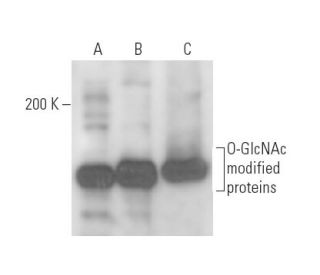

Anticorpo O-GlcNAc (CTD110.6): sc-59623
- O-GlcNAc Antibody CTD110.6 è un monoclonale di topo IgM κ O-GlcNAc antibody, citato in 71 pubblicazioni, fornito in 200 µg/ml
- sensibilizzato contro O-GlcNAc contenente N-acetilglucosamina legata a serina-O
- raccomandato per il rilevamento di Ser-O-GlcNAc and Thr-O-GlcNAc di origine a broad range of species, including mammals, insects, worms, plants e filamentous fungi in WB e IP; non cross-reattivo con peptide determinants or other closely-related carbohydrate antigens
- Vedere O-GlcNAc (RL2): sc-59624 for O-GlcNAc per anticorpi coniugati, tra cui AC, HRP, FITC, PE, Alexa Fluor® 488, 594, 647, 680 e 790.
- Al momento non abbiamo ancora completato l'identificazione dei reagenti secondari di rilevazione preferiti per O-GlcNAc l'anticorpo (CTD110.6). Questo lavoro è in corso.
LINK RAPIDI
L'anticorpo O-GlcNAc (CTD110.6) è un anticorpo monoclonale di topo IgM κ O-GlcNAc (designato anche anticorpo O-linked β-N-acetylglucosamine, anticorpo O-β-GlcNAc, anticorpo O-linked GlcNAc, anticorpo O-GlcNAc serina idrossile, anticorpo anti O-GlcNAc idrossile di treonina o anticorpo specifico per l'O-GlcNAcilazione) che rileva le proteine O-GlcNAc di un'ampia gamma di specie, tra cui mammiferi, insetti, vermi, piante e funghi filamentosi, mediante WB e IP. L'anticorpo O-GlcNAc (CTD110.6) è disponibile come anticorpo anti-O-GlcNAc non coniugato. L'O-GlcNAc (N-acetilglucosamina legata a O) è una forma di glicosilazione proteica che si trova esclusivamente nel nucleo e nel citoplasma delle cellule eucariotiche. Molte proteine sono modificate in corrispondenza dei loro gruppi idrossilici di serina e treonina dall'attacco di O-GlcNAc. Le proteine che regolano il traffico dentro e fuori il poro nucleare sono ampiamente O-GlcNAcilate. Le proteine O-GlcNAc fosforilate formano complessi multimerici reversibili con altre proteine e queste associazioni sono spesso regolate dalla fosforilazione. Le proteine O-GlcNAc possono svolgere un ruolo chiave nella patogenesi dei tumori e di varie cellule tumorali. I residui di O-GlcNAc regolano l'assemblaggio del complesso di preiniziazione e sono quindi importanti nell'iniziazione trascrizionale. Le proteine O-GlcNAc citoscheletriche e di membrana mantengono la forma della cellula eritrocitaria e regolano la degradazione delle proteine responsabili delle lesioni nella malattia di Alzheimer.
Alexa Fluor® è un marchio registrato di Molecular Probes Inc., OR., USA
LI-COR® e Odyssey® sono marchi registrati di LI-COR Biosciences
Anticorpo O-GlcNAc (CTD110.6) Riferimenti:
- Il gene della O-GlcNAc transferasi risiede sul cromosoma X ed è essenziale per la vitalità delle cellule staminali embrionali e per l'ontogenesi del topo. | Shafi, R., et al. 2000. Proc Natl Acad Sci U S A. 97: 5735-9. PMID: 10801981
- Localizzazione della O-GlcNAc transferasi e delle proteine O-GlcNAc-modificate nella corteccia cerebellare di ratto. | Akimoto, Y., et al. 2003. Brain Res. 966: 194-205. PMID: 12618343
- Glicosilazione di proteine nucleari e citoplasmatiche. Purificazione e caratterizzazione di una uridina difosfo-N-acetilglucosamina:polipeptide beta-N-acetilglucosaminiltransferasi. | Haltiwanger, RS., et al. 1992. J Biol Chem. 267: 9005-13. PMID: 1533623
- Identificazione dell'agente segreto come O-GlcNAc transferasi che partecipa all'infezione da Plum pox virus. | Chen, D., et al. 2005. J Virol. 79: 9381-7. PMID: 16014901
- Un saggio ad alto rendimento per la O-GlcNAc transferasi rileva le preferenze di sequenza primaria nei substrati peptidici. | Leavy, TM. and Bertozzi, CR. 2007. Bioorg Med Chem Lett. 17: 3851-4. PMID: 17531489
- La segnalazione dei fosfoinositidi collega la O-GlcNAc transferasi all'insulino-resistenza. | Yang, X., et al. 2008. Nature. 451: 964-9. PMID: 18288188
- O-GlcNAc Transferasi: caratteristiche strutturali, meccanismo catalitico e inibitori a piccole molecole. | Ju Kim, E. 2020. Chembiochem. 21: 3026-3035. PMID: 32406185
- I progressi nell'analisi chimica della glicosilazione O-GlcNAc delle proteine: ruolo strutturale e meccanismi molecolari. | Saha, A., et al. 2021. Chem Soc Rev. 50: 10451-10485. PMID: 34338261
- Integrazione dell'O-GlcNAc nei percorsi di risposta allo stress. | Fahie, KMM., et al. 2022. Cells. 11: PMID: 36359905
- La modifica dell'O-GlcNAc della GSDMD attenua la piroptosi delle cellule endoteliali indotta da LPS. | Yu, F., et al. 2024. Inflamm Res. 73: 5-17. PMID: 37962578
- Glicosilazione dinamica di proteine nucleari e citosoliche. Clonazione e caratterizzazione di un'unica O-GlcNAc transferasi con ripetizioni multiple di tetratricopeptidi. | Kreppel, LK., et al. 1997. J Biol Chem. 272: 9308-15. PMID: 9083067
- La O-Linked GlcNAc transferase è una proteina nucleocitoplasmatica conservata contenente ripetizioni tetratricopeptidiche. | Lubas, WA., et al. 1997. J Biol Chem. 272: 9316-24. PMID: 9083068
Informazioni ordini
| Nome del prodotto | Codice del prodotto | UNITÀ | Prezzo | Quantità | Preferiti | |
O-GlcNAc Anticorpo (CTD110.6) | sc-59623 | 200 µg/ml | RMB2377.00 |
